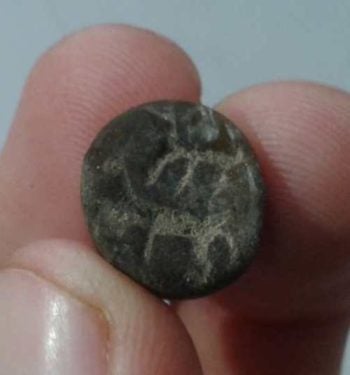Russian boy finds 3,000-year-old artifact in earth salvaged from Temple Mount
Published September 27, 2015

The seal, shortly after it was discovered. (Temple Mount Sifting Project)
(JTA) — A rare stone artifact dating to the 10th century BCE has been found in Jerusalem by a 10-year-old volunteer.
A Russian tourist volunteering for Jerusalem’s Temple Mount Sifting Project unearthed the small, animal-inscribed limestone item, believed to be used for sealing documents, the organization said in a statement.
The 11-year-old Temple Mount Sifting Project, under the auspices of Bar-Ilan University, searches through thousands of tons of earth the Islamic Waqf illegally removed from the Temple Mount in 1999 as it was building a mosque.
“The seal is the first of its kind to be found in Jerusalem,” said Gabriel Barkay, co-founder and director of the Temple Mount Sifting Project. “The dating of the seal corresponds to the historical period of the Jebusites and the conquest of Jerusalem by King David, as well as the construction of the Temple and the royal official compound by his son, King Solomon.”
“What makes this discovery particularly significant,” Barkay added, “is that it originated from upon the Temple Mount itself.”
Matvei Tcepliaev, a 10-year-old boy unearthed the seal sometime in the past six months, but archaeologists only recently deciphered it.
More than 170,000 volunteers from Israel and around the world have participated in sifting through the salvaged earth.
“Since the Temple Mount has never been excavated, the ancient artifacts retrieved in the Sifting Project provide valuable and previously inaccessible information,” said Zachi Dvira, the project’s co-founder and director. “The many categories of finds are among the largest and most varied ever found in Jerusalem. Even though they have been extracted from their archaeological context, most of these artifacts can be identified and dated by comparing them with those found at other sites.”
Dvira added that in the past few years “newly developed statistical methodologies and technologies” have enabled the project to “overcome the challenge of having finds with no exact context since they were not recovered in a proper archaeological excavation.”
More than half a million items unearthed by volunteers “are still waiting to be processed and analyzed in our laboratory,” said Dvira.
This entry passed through the Full-Text RSS service – if this is your content and you’re reading it on someone else’s site, please read the FAQ at fivefilters.org/content-only/faq.php#publishers.












